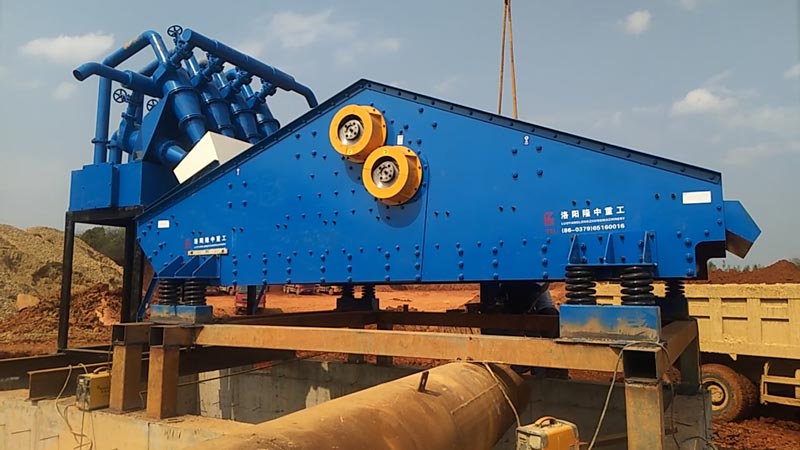
Menu
 LDHB Machines
LDHB Machines
At present, the dehydration and desilting screen is developing in the direction of large-scale. Two-channel or three-channel linear vibrating screen is the future development direction. When the material with moisture content above 50 is dewatered, an arc screen should be equipped before the vibrating screen. The arc screen has a great drainage capacity. After the water-containing material enters the vibrating screen, the dewatering effect mainly depends on the vibration frequency and the flow speed of the material. The higher the frequency, the slower the flow rate, the better the effect. For dehydration with a sieve hole of 0.5 ram, it is recommended that users use a 960-rain linear sieve, and a 1460-rain high-frequency sieve with a sieve hole of 0.3 mm or less.
For the grading and dehydration of clean coal after jigging, we recommend that users choose the new 2ZKB type dehydration screen with a single-layer 0.5 ram screen surface in the first stage, and the material moving at a negative inclination angle is slower. The second stage is a double layer, the upper layer is 13ram or 6mm sieve hole, and the lower layer is 0.5ram sieve hole for material classification and dehydration. This structure will make the sieve have a higher dewatering effect. More importantly, it is more convenient to replace the lower sieve plate.
As a high-frequency vibrating screen for fine-grained slime recovery, the domestic use is not very good, mainly because the feed concentration is too small. The concentration of the material entering the high-frequency sieve must not be lower than 45. In this way, the water content of the product can generally be below 28. If the water content is still high, spray air on the sieve surface according to foreign experience, which can reduce the water content by 1 to 2 percentage points.

Selection calculation
The user should provide the following information when selecting the sieve machine, so as to calculate the size of the sieve
Information on the basis of selection
①The purpose of the sieve.
② Material characteristics: type, bulk density, moisture, particle shape, particle size composition, maximum feeding, particle size, material viscosity.
③ Work shift system.
④ Processing capacity.
⑤ Specify the particle size and the corresponding screening efficiency.
⑥Sifting method (wet sieve or dry sieve).
⑦Installation method. Base or hanging type, the motor is installed on the left or right.
⑧The type of sieve surface you want to use
⑨ The type of vibrating screen you want to use.
⑩ Working conditions. Such as space size, ambient temperature, dustproof requirements, etc. Because the actual situation is very complicated, the selection and calculation methods of screening machines at home and abroad are very inconsistent, and some sieves have not yet successfully selected the calculation formula. Here, we recommend the method that we think is more mature.